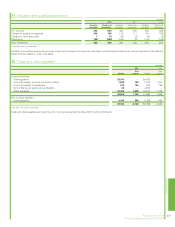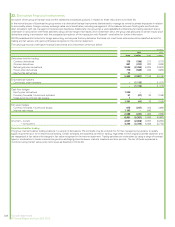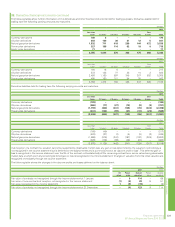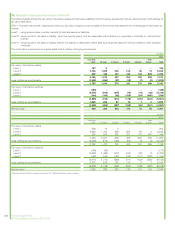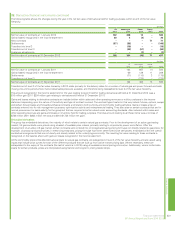BP 2012 Annual Report Download - page 223
Download and view the complete annual report
Please find page 223 of the 2012 BP annual report below. You can navigate through the pages in the report by either clicking on the pages listed below, or by using the keyword search tool below to find specific information within the annual report.
Financial risk factors
The group is exposed to a number of different financial risks arising from natural business exposures as well as its use of financial instruments including:
market risks relating to commodity prices, foreign currency exchange rates, interest rates and equity prices; credit risk; and liquidity risk.
The group financial risk committee (GFRC) advises the group chief financial officer (CFO) who oversees the management of these risks. The GFRC is
chaired by the CFO and consists of a group of senior managers including the group treasurer and the heads of the group finance, tax and the integrated
supply and trading functions. The purpose of the committee is to advise on financial risks and the appropriate financial risk governance framework for
the group. The committee provides assurance to the CFO and the group chief executive (GCE), and via the GCE to the board, that the group’s financial
risk-taking activity is governed by appropriate policies and procedures and that financial risks are identified, measured and managed in accordancewith
group policies and group risk appetite.
The group’s trading activities in the oil, natural gas and power markets are managed within the integrated supply and trading function, while the
activities in the financial markets are managed by the treasury function, working under the compliance and control structure of the integrated supplyand
trading function. All derivative activity is carried out by specialist teams that have the appropriate skills, experience and supervision. These teams are
subject to close financial and management control.
The integrated supply and trading function maintains formal governance processes that provide oversight of market risk associated with trading activity.
A policy and risk committee monitors and validates limits and risk exposures, reviews incidents and validates risk-related policies, methodologiesand
procedures. A commitments committee approves value-at-risk delegations, the trading of new products, instruments and strategies and material
commitments.
In addition, the integrated supply and trading function undertakes derivative activity for risk management purposes under a separate control framework
as described more fully below.
(a) Market risk
Market risk is the risk or uncertainty arising from possible market price movements and their impact on the future performance of a business. The
primary commodity price risks that the group is exposed to include oil, natural gas and power prices that could adversely affect the value of the group’s
financial assets, liabilities or expected future cash flows. The group enters into derivatives in a well-established entrepreneurial trading operation. In
addition, the group has developed a control framework aimed at managing the volatility inherent in certain of its natural business exposures. In
accordance with the control framework the group enters into various transactions using derivatives for risk management purposes.
The group measures market risk exposure arising from its trading positions using value-at-risk techniques. These techniques are based on Monte Carlo
simulation and make a statistical assessment of the market risk arising from possible future changes in market prices over a one-day holding period. The
calculation of the range of potential changes in fair value takes into account a snapshot of the end-of-day exposures and the history of one-day price
movements, together with the correlation of these price movements. The value-at-risk measure is supplemented by stress testing.
The value-at-risk table does not incorporate any of the group’s natural business exposures or any derivatives entered into to risk manage those
exposures. Market risk exposure in respect of embedded derivatives is also not included in the value-at-risk table.
Value-at-risk limits are in place for each trading activity and for the group’s trading activity in total. The board has delegated a limit of $100 million value at
risk in support of this trading activity. The high and low values at risk indicated in the table below for each type of activity are independent of each other.
Through the portfolio effect the high value at risk for the group as a whole is lower than the sum of the highs for the constituent parts. The potential
movement in fair values is expressed to a 95% confidence interval. This means that, in statistical terms, one would expect to see a decrease in fair
values greater than the trading value at risk on one occasion per month if the portfolio were left unchanged.
$ million
Value at risk for 1 day at 95% confidence interval 2012 2011
High Low Average Year end High Low Average Year end
Group trading 51 19 34 25 83 28 42 28
Oil price trading 50 18 31 23 84 23 39 27
Gas and power trading 30 4 12 8 20 6 11 7
The major components of market risk are commodity price risk, foreign currency exchange risk, interest rate risk and equity price risk, each of which is
discussed below.
(i) Commodity price risk
The group’s integrated supply and trading function uses conventional financial and commodity instruments and physical cargoes available in the related
commodity markets. Oil and natural gas swaps, options and futures are used to mitigate price risk. Power trading is undertaken using a combination of
over-the-counter forward contracts and other derivative contracts, including options and futures. This activity is on both a standalone basis and in
conjunction with gas derivatives in relation to gas-generated power margin. In addition, NGLs are traded around certain US inventory locations using
over-the-counter forward contracts in conjunction with over-the-counter swaps, options and physical inventories. Trading value-at-risk information in
relation to these activities is shown in the table above.
As described above, the group also carries out risk management of certain natural business exposures using over-the-counter swaps and exchange
futures contracts. Together with certain physical supply contracts that are classified as derivatives, these contracts fall outside the value-at risk
framework. For these derivative contracts the sensitivity of the net fair value to an immediate 10% increase or decrease in all reference prices would
have been $16 million at 31 December 2012 (2011 $23 million). This figure does not include any corresponding economic benefit or disbenefit that
would arise from the natural business exposure which would be expected to offset the gain or loss on the over-the-counter swaps and exchange futures
contracts mentioned above.
In addition, the group has embedded derivatives relating to certain natural gas contracts. The net fair value of these contracts was a liability of $1,112
million at 31 December 2012 (2011 liability of $1,417 million). Key information on the natural gas contracts is given below.
At 31 December 2012 2011
Remaining contract terms 2 years and 5 months to 5 years and 9 months 3 years and 5 months to 6 years and 9 months
Contractual/notional amount 117 million therms 952 million therms
Financial statements 221
BP Annual Report and Form 20-F 2012
Financial statements
26. Financial instruments and financial risk factors continued


















